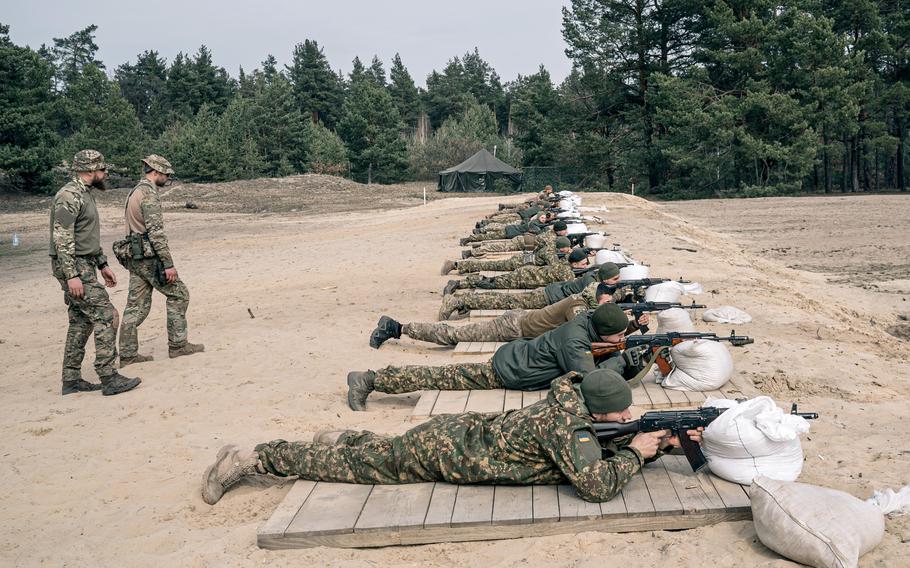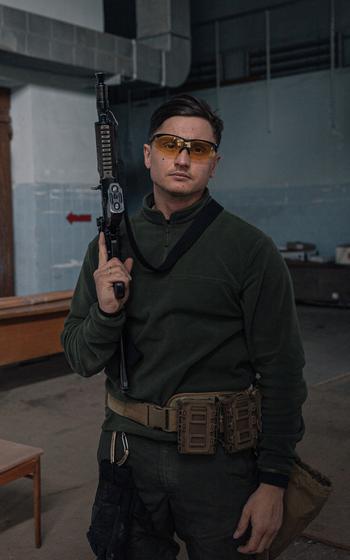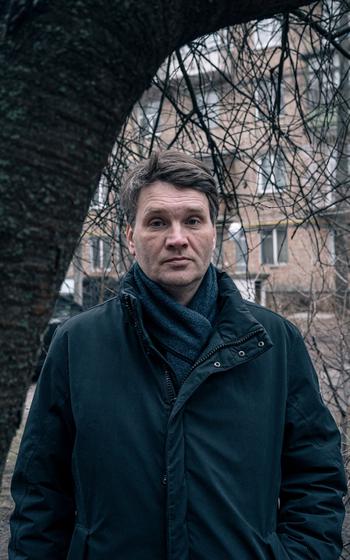Europe
As spring offensive nears, Ukraine is drafting reinforcements
The Washington Post April 10, 2023

Recruits attend shooting practice at an Azov Brigade training camp outside Kyiv on March 24. (Alice Martins/The Washington Post)
KYIV, Ukraine — The men in uniform could show up almost anywhere, any time.
They knock on civilians' front doors and randomly stop them on street corners, handing out draft papers that can turn lives upside down.
Ukraine needs more soldiers — and fast. Kyiv is preparing for an imminent assault on Russian occupying forces, and while Ukraine does not disclose its casualty counts, commanders in the field have described large losses. In a trove of leaked classified files, the U.S. government recently estimated that between 124,000 and 131,000 Ukrainian soldiers had been killed or wounded since the start of the invasion — more than five times what Kyiv has publicly disclosed.
"We need to understand if the war lasts another year, we're all going to be in the army," said Sasha, 35, a casting director and amateur kickboxer who is taking a private military training course in the capital in case he is drafted. He spoke on the condition that only his first name be used, because of concerns over publicizing his mobilization status.

Sasha, 35, a casting director and amateur kickboxer, at a private military training course in Kyiv on March 26. (Alice Martins/The Washington Post)
The much-hyped counteroffensive will rely on both new soldiers and more experienced troops newly trained on donated Western equipment, including Leopard 2 tanks. And the pace and aggression with which officials are now calling on civilian men to report to military offices — or sign up on their own — are sowing panic among those who feel unprepared or unwilling to serve.
Previously, officials could only deliver draft papers to people's homes, and some avoided the notices by staying at different addresses than where they are officially registered. But new rules have widened the scope of places where men can be stopped and questioned about their draft status.
Martial law in place in Ukraine since February 2022 bars most men between ages 18 and 60 from leaving the country. Under mobilization rules, any man in that range can theoretically be called to fight. Exceptions are made, including for students; parents with three or more children under 18; caretakers of disabled dependents; and those deemed medically unfit, among others.
Almost a quarter-million Ukrainians will turn 18 this year — making them old enough to sign up to fight, or, if they're male and still in the country, too old to leave.
The Ukrainian army has long relied on volunteers. But now many Ukrainian men — even those working as volunteers or doing other useful jobs as civilians — cannot escape the draft, or at least registering in military offices.

Oleksii Kruchukov, a washing machine repairman, waits in line outside a recruitment office in Kyiv. He said he was ordered to report there after police broke up a fight he got into. (Alice Martins/The Washington Post)
Oleksii Kruchukov, 46, a washing machine repairman waiting in line outside a recruitment office in Kyiv, said he was ordered to report there after police broke up a fight he got into on the street. He did not have any valid military exemptions and said he expected that the incident will result in him soon being sent to training, and then the front.
Oleksandr Kostiuk, 52, a road repairman who helped set up barriers against Russian forces around Kyiv last year, recently received his notice via his human resources department at work. He is willing to go to the front if he has to — but fears for his safety. "Now we understand what's going on, so I'm more nervous," he said.
Thousands of other civilians are preempting such situations, instead signing up in droves for a force called the Offensive Guard — made up of eight new assault brigades.
Some are responding to the posters plastered across the country's highways calling on civilians to join — and "turn your rage into a weapon." The young men may have recently turned 18 and now qualify, or have cleared up family obligations that previously stopped them from joining. Others hope enlisting of their own accord will give them better training and prestige than if they were drafted.
Since early February, more than 5,000 people have applied to join what was formerly known as the Azov Battalion, a controversial former right-wing militia that was incorporated into Ukraine's national guard. Last year, the battle-hardened group was hailed as heroic for withstanding a months-long siege of the southeastern city of Mariupol.
Then, in February, the Ukrainian Interior Ministry announced that Azov would be expanded into an assault brigade as part of the new Offensive Guard.
Under its rules, Azov only accepts those who sign up of their own accord — not draftees — and it reserves the right to reject people whom it does not believe will be a good fit, which it says allows it to select the most motivated soldiers. Azov has launched a massive recruitment campaign for its new status as a brigade, with many of its men who were captured in Mariupol last year and eventually released now training recruits.
Other civilians, unwilling to enlist just yet but preparing in case they are called up, are attending private trainings or workout sessions so that when the time comes, they are not starting from scratch.
"I'm 100 percent sure I'll be drafted sooner or later," Sasha, the casting director informally training with friends in the capital, said. Despite having taken a military course at university that would technically qualify him to serve as an officer in the army, he could barely handle a weapon until recently. Now he believes his civilian days are numbered, "especially with the counteroffensive everyone is waiting for," and he has enrolled in training.
"I'm literally forcing myself because I understand it might happen," he said.
His worst fear, he said, is that even after attending basic training, he will not feel ready to fight.
That concern is not unfounded.
On a recent afternoon outside Lyman in eastern Ukraine, a seasoned enlisted leader vented about the quality of initial training among newly arrived troops, describing it as largely glossing over fundamentals needed in the field that have to be taught when they get to their units.
"They're taught to sing songs and march" in basic training, the leader said, speaking on the condition of anonymity because he was not authorized to speak with reporters.
Once deployed, the troops need instruction even on the most ancient practice of soldiering: how to dig, the leader said. They do not know how to hold their shovels or fortify trenches and fighting positions. For practice, a group of fresh troops dug their spades into a nearby trench line.
The leader walked an instruction line to teach four soldiers how to change their rifle magazines during a firefight, explaining that it won't be so easy to just stand there. You need to take cover, he explained. Often you'll need to do it a prone position. The unloaded rifles clicked in discord as the trainees ran through the drills.
Some of them struggled to move quickly and smoothly through the steps of inserting a fresh magazine and sliding the bolt forward. The instructor singled out the worst performer and yelled.
"Adjust your sling!" he roared, as the soldier fidgeted with his weapon. "How are you going to shoot with your sling twisted like that?"
Volunteers fill out forms before being interviewed at an Azov Brigade recruitment center in Kyiv on March 21. (Alice Martins/The Washington Post)
Meanwhile, at a training camp in the Kyiv region, new Azov recruits lined up at a shooting range, learning to use C7A1 rifles. One of their trainers, a Russian-speaking former American Marine who joined Azov and goes by the call sign Frodo, said that "the majority of these guys a month ago were civilians." One sat against a wall, studying a translated U.S. military handbook.
That they were motivated enough to sign up on their own means they act more like "warriors than soldiers," Frodo said.
The training condenses the roughly three-month U.S. Marine Corps basic training into just four weeks, he said. During that time, the troops learn everything from marksmanship and cartography to radios and engineering. It's possible - likely even - they could then be deployed almost immediately to the country's hottest front lines.
In one tent, dozens of men sat in rows as an instructor went over the different types of mines they needed to be able to identify in the field. Outside, a group of men came jogging across the sand - then all came to an abrupt halt and lit up cigarettes. They only get three smokes a day, Frodo explained, and during training, they are required to run everywhere they go.
"It's a short period to build discipline," he said.
It's fear over this lack of readiness that pushed Sasha and eight other men to attend training at an abandoned warehouse in Kyiv on a recent Sunday. They ran up the stairs in twos and threes, rifles raised to their shoulders as they paused on each landing to check for Russian troops.
"Bam! Bam! Bam! I made contact!" one shouted. Then came a new threat from above: "GRENADE!"
They all hit the floor — but nothing exploded. The grenade was plastic, the Russian soldier was cardboard, the warehouse was in an area under Ukrainian control and the consequences for mistakes were minimal. "Whoever died stupidly, you do 30 squats!" the commander yelled.
Their trainer — an active-duty serviceman who trains the men in between assignments and spoke on the condition of anonymity because of security concerns — said that day's drills were intended to prepare these civilian men, who work in IT, advertising and project management, to clear an area of any Russian forces left over after a counteroffensive.
"I can kill 10 Russians, but if I teach 10 others how to kill, they might kill 100 Russians," he said. "When I see their motivation and their energy it gives me shivers. Their motivation is my motivation."
If they do end up on the front, he said, his main goal "is for them to live for as long as possible."
Kamila Hrabchuk in Kyiv and Alex Horton and Anastacia Galouchka in Lyman contributed to this report.